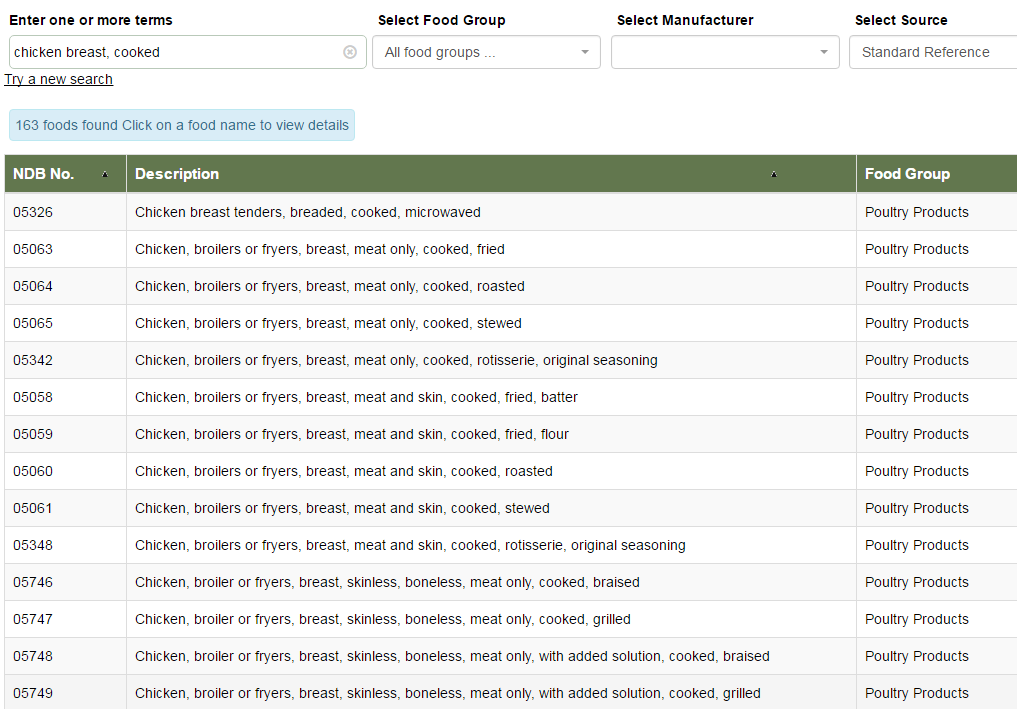Chicken Breast

Lunachic77
Posts: 434 Member
Can anyone please provide (or let me copy from their diary) a correct and accurate boneless chicken breast, cooked entry? I have searched the database and can't find one that is confirmed by more than 1 user. This website has changed a little bit since I was last active, and the list of chicken breast is enormous and some are very inaccurate. I appreciate the help, thanks
0
Replies
-
Try weighing raw and using an entry that matches USDA information.
Cooked entries will vary because everyone has different cooking methods and it may produce different results. These entries are user-generated so someone may have created an entry that included cooking oil but did not specify in the entry.1 -
I've always searched the way I cooked the chicken have either it in ounces. Ex: grilled chicken or pan fried chicken. Picked the one that made the most sense. I've never had a problem losing weight (if I'm being honest & weighing/logging every bite)
Counting calories, no matter how accurate you try to be, will always have a little big of wiggle from. There is no way to have a completely and totally accurate count for the day. Make peach with it. Try to be accurate, but don't drive yourself crazy. Then move on.3 -
I'm having chicken tomorrow, from the packet it's 213cals for 1 chicken breast at 150g.0
-
We buy ours from Wal-Mart, boneless, skinless. There's a confirmed entry in the diary for them as well as the boneless skinless chicken thighs from there. Makes it easy to log. But, when in doubt, the USDA calories for chicken breast are the best to use, so use any entry that is close to theirs for 1oz.0
-
Get the syntax for foods like this from the USDA database: https://ndb.nal.usda.gov/ndb/search/list

And plug that into MFP.0 -
Unfortunatelt there is no USDA entry for grilled chicken breast and their entry for cooked breast is way off the package nutrition info from Perdue or Wegmans for cooked chicken breast.. Probably because it's trimmed and not coming directly from a whole chicken. So honestly I just use Perdue entries now (120 calories for 3oz cooked).. and I trim all the fat anyway.0
-
This may seem a weird method, but I looked up the USDA yield rate for different meats after cooking. For chicken in direct heat, it's about 75-80%, so I use the package calories, but log a serving 25% larger than I actually eat.
I did verify this myself. I weighed some breasts, grilled them, and weighed again. The cooked mass averaged 78% of the raw mass.1 -
This may seem a weird method, but I looked up the USDA yield rate for different meats after cooking. For chicken in direct heat, it's about 75-80%, so I use the package calories, but log a serving 25% larger than I actually eat.
I did verify this myself. I weighed some breasts, grilled them, and weighed again. The cooked mass averaged 78% of the raw mass.
Wegmans lists calories for cooked and raw, usually, and 3oz cooked is the same as 4oz raw, which seems about the same (plus you'll lose fat when you cook the meat anyway).0 -
samanthaluangphixay wrote: »Try weighing raw and using an entry that matches USDA information.
.
This is what I do.0 -
samanthaluangphixay wrote: »Try weighing raw and using an entry that matches USDA information.
.
This is what I do.
Same. So much easier.0 -
This content has been removed.
-
How much moisture evaporates in cooking varies widely based on cooking method, internal temperature, how long it's cooled after cooking, etc. Weigh raw if you can. If you're cooking big batches for many meals, weigh before & after and pro rate it. Or just guess. Weighing raw is more accurate but guessing is unlikely to be more than 20% off. Your deficit (and protein requirement) may tolerate that margin of error. Some people are interested in their own data and strive for accuracy whereas others don't care so long as they're getting results.0
This discussion has been closed.
Categories
- All Categories
- 1.4M Health, Wellness and Goals
- 397K Introduce Yourself
- 44.2K Getting Started
- 260.9K Health and Weight Loss
- 176.3K Food and Nutrition
- 47.6K Recipes
- 232.8K Fitness and Exercise
- 456 Sleep, Mindfulness and Overall Wellness
- 6.5K Goal: Maintaining Weight
- 8.7K Goal: Gaining Weight and Body Building
- 153.3K Motivation and Support
- 8.3K Challenges
- 1.3K Debate Club
- 96.5K Chit-Chat
- 2.6K Fun and Games
- 4.5K MyFitnessPal Information
- 16 News and Announcements
- 18 MyFitnessPal Academy
- 1.4K Feature Suggestions and Ideas
- 3.1K MyFitnessPal Tech Support Questions










